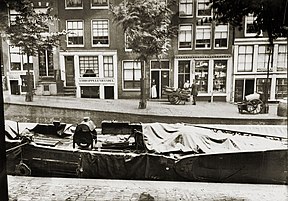Lauriergracht
| Lauriergracht | |
|---|---|
 Lauriergracht numbers 1 to 9, an 1895 photograph from the George Hendrik Breitner collection[1] | |
| Location | Amsterdam |
| Country | Netherlands |
| Coordinates | 52°22′16″N 4°52′48″E / 52.3712°N 4.8800°E |
The Lauriergracht (Dutch pronunciation: [lʌuˈriːrˌɣrɑxt]; literally "Laurel Canal"[2]) is one of the canals of Amsterdam, located in the Jordaan, west of the Grachtengordel.
History and inhabitants

It was painted and photographed by George Hendrik Breitner who set up a studio on the canal, at number 8, in 1893 and stayed there until 1898.[4][5] His De Lauriergracht bij de Tweede Laurierdwarsstraat (painted in 1917–1918) is in the Rijksmuseum.[6] Prints of his paintings of Lauriergracht 1-15 are in the
At the end of the 17th century, the Lauriergracht had been the residence of several artists and their relatives.[8]
One of the famous residents of the Lauriergracht is the fictional
The house on number 122 was built in 1889 by architect Herman Hendrik Baanders, the first of a series of successful and impressive designs by his hand.[18]
Numbers 130 and 132 used to be a Christian Reformed Church; originally opened on 14 November 1900 and reopened on 21 December 1927 after an extension, the church was finally closed on 14 November 1985 and turned into apartments.[19] The Evangelical Lutheran Church built an orphanage at numbers 112–118 in 1757.[20]
Numbers 103 and 105 are another orphanage, a Roman Catholic one for boys that was built in the 17th century, run by the Brothers of Maastricht from 1845 to 1900, and by the aforementioned Sisters of Providence from then onwards.[21]
References
Cross-references
- ^ Beeldbank 2019a.
- ^ Michelin 2001, p. 128.
- ^ Jonker & Sluyterman 2001, p. 164.
- ^ Bothe 1898, p. 32.
- ^ Pols 1966, p. 129.
- ^ Rijksmuseum 2019a.
- ^ Beeldbank 2019b.
- ^ Nguyen 1992, p. 36.
- ^ Kilian 2007, p. 13.
- ^ Kok 2016, p. 49.
- ^ Grape-Albers 1997, p. 84.
- ^ Dickey 2013, p. 140.
- ^ Nieuwenhuys 1982, pp. 88–89.
- ^ Niekerk 2000, p. 175.
- ^ Beekman 1982, pp. 366.
- ^ Impens 2012.
- ^ Nijeboer & van Wissen.
- ^ van Rossem 2008.
- ^ RD 1985.
- ^ Meiners 1988, p. 77.
- ^ van Heijst 2002, p. 70.
Sources
- "Lauriergracht 1-9 (v.l.n.r.)". Beeldbank. 010104000079.
- "Lauriergracht 1-15. Prentbriefkaart van schilderij van Breitner uit 1895 in Stedelijk Museum. Uitgave Gebr. van R. Amsterdam". Beeldbank. PBKD00104000001.
- "De Lauriergracht bij de Tweede Laurierdwarsstraat, George Hendrik Breitner, 1917–1918". Rijksmuseum. SK-A-3546.
- Beekman, E. M. (1982). "Afterword". Max Havelaar, Or, The Coffee Auctions of the Dutch Trading Company. Univ of Massachusetts Press. ISBN 9780870233593.
- Bothe, Adolf (1898). Adressbuch von bildenden Künstlern der Gegenwart. Selbstverlag des Herausgebers.
- Dickey, Stephanie S. (2013). "Flinck, Govaert". In Muller, Sheila D. (ed.). Dutch Art: An Encyclopedia. Garland Reference Library of the Humanities. Vol. 1021. Routledge. ISBN 9781135495749.
- Grape-Albers, Heide, ed. (1997). "Die ′Lauriergracht′". Niederdeutsche Beiträge zur Kunstgeschichte. Vol. 36. ISBN 9783422062320.
- Impens, Chris (2012-06-28). "Lauriergracht 37 Amsterdam" (in Dutch).
- Jonker, Joost; Sluyterman, Keetie (2001). "Through a dark valley, 1750–1850". At Home on the World Markets: Dutch International Trading Companies from the 16th Century Until the Present. McGill-Queen's Press. ISBN 9780773569386.
- Kilian, Jennifer (2007). Karel du Jardin, 1628–1678. Rijksmuseum/Nieuw Amsterdam. ISBN 9789086890309.
- Kok, Erna (2016). Netwerkende kunstenaars in de Gouden Eeuw: De succesvolle loopbanen van Govert Flinck en Ferdinand Bol. Zeven Provinciën reeks. Vol. 36. Uitgeverij Verloren. ISSN 0925-7586.
- Meiners, J. L. J. (1988). "Historicht overzicht". In Happee, J.; Meiners, J. L. J.; Mostert, Marco (eds.). De Lutheranen in Amsterdam, 1588–1988: gedenkboek ter gelegenheid van 400 jaar Evangelisch-Lutherse Gemeente te Amsterdam. Uitgeverij Verloren. ISBN 9789065503138.
- Amsterdam and Environs. Michelin green guides (2nd ed.). Michelin Travel Publications. 2001. ISSN 0763-1383.
- Nguyen, Kristina Hartze (1992). "The Made Landscape: City and Country in Seventeenth-century Dutch Prints". Harvard University Art Museums bulletin. Vol. 1, no. 1. Harvard University Art Museum.
- Niekerk, Carl H. (2000). "Race and gender in Multatuli's Max Havelaar and Love Letters". In Finke, Michael C.; Niekerk, Carl H. (eds.). One Hundred Years of Masochism: Literary Texts, Social and Cultural Contexts. Rodopi. ISBN 9789042006577.
- Nieuwenhuys, Robert (1982). "Edward Browes Dekker". In Beekman, E. M. (ed.). Mirror of the Indies: A History of Dutch Colonial Literature. Translated by Van Rosevelt, Frans. University of Massachusetts Press. ISBN 9780870233685.
- Nijeboer, Egbert; van Wissen, Kees. "Geschiedenis van de RK Kweekschool en Pedagogische Academie 'De Voorzienigheid' te Amsterdam, 1897–1984". De Brug (in Dutch).
- Pols, Ivor Vincent (1966). George Hendrik Breitner. Amsterdam.
- "Laatste dienst in Chr. Geref. kerk Amsterdam". Reformatorisch Dagblad. digibron. 1985-11-14. p. 2.
- van Heijst, Annelies (2002). "Heren in vereniging: stand en liefdadigheid". Liefdewerk: een herwaardering van de caritas bij de Arme Zusters van het Goddelijk Kind, sinds 1852. Uitgeverij Verloren. p. 70. ISBN 9789065507419.
- van Rossem, Vincent (February 2008). "Amsterdam 1900: H.H. Baanders (1849-1905), H.A.J. Baanders (1876-1953), J. Baanders (1884-1966)". Binnenstad (in Dutch). No. 226. Vereniging Vrienden van de Amsterdamse.
Further reading
- Graves, W.J. (1985). De Lauriergrachtkerk in Amsterdam, 1900 - 14 november - 1985. Christelijke Gereformeerde Kerk.
- Lammertse, Friso; van der Veen, Jaap (2006). "The House on Lauriergracht". Uylenburgh & son: art and commerce from Rembrandt to De Lairesse, 1625–1675. The Oliver Millar Collection. Waanders Publishers.
- Meischke, R. (July 1981). "Het R.C. jongensweeshuis aan de Lauriergracht in het eind van de achttiende eeuw". Maandblad Amstelodamum. 73: 82–103.
- van Heel, S. A. C. Dudok (1982). "Het "schilderhuys" van Govert Flinck en de kunsthandel van Uylenburgh aan de Lauriergracht te Amsterdam". Jaarboek Amstelodamum. 74. J. H. de Bussy: 70–90.

